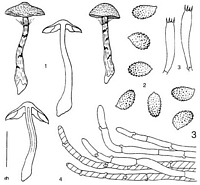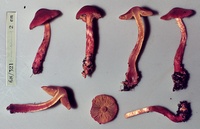|
 Dermocybe cramesina Dermocybe cramesina
SynonymsCortinarius cramesinus
BiostatusPresent in region - Indigenous. Non endemic
Images (click to enlarge)
Caption: Dermocybe cramesina: 1. carpophores. - 2. spores. - 3. basidia. - 4. pileipellis. | 
Caption: ZT68-321 , Holotype
Owner: E. Horak: © Creative Commons Attribution-Noncommercial 3.0 New Zealand |
Article: Horak, E. (1988) [1987]. New species of Dermocybe (Agaricales) from New Zealand. Sydowia 40: 81-112.
Description: Pileus -30 mm, convex to broadly umbonate or campanulate; uniformly cinnabar red or crimson red, purple tints absent; dry, minutely squamulose, neither hygrophanous nor striate near margin. - Lamellae 10-16, 3(-5), broadly adnate-emarginate, ventricose, -5 mm wide; yellow-ochre becoming ochre-ferruginous, edges concolorous, entire. - Stipe -50 x –4 mm, distinctly fusoid or clavate (base-10 mm diam.), cespitose or single; yellow-ochre at apex, from cortina (composed of ochre fibrils) to base densely covered with cinnabar red or crimson red coarse fibrils or several appressed zones of veil; dry, longitudinally fibrillose, solid. - Context orange, orange-brown in base of stipe. - Odour and taste raphanoid (occasionally with slight component of raw potato). - Chemical reactions on pileus: KOH - black (with lilac tinge); HCl, NH3 - negative.
Spore print rust brown. - Spores 6-7 x 4- 4.5 µm, ovoid, minutely verrucose, rust brown. - Basidia 25-35 x 7-8 µm, 4-spored. - Cheilocystidia absent. - Pileipellis a cutis or trichoderm of cylindrical hyphae (5-12 µm diam.), terminal cells cylindrical or conical, membranes not gelatinized, purple plasmatic pigment slowly turning to grey and finally black, weakly dissolving in KOH. - Clamp connections present.
Habitat: On soil in Nothofagus-forests (N. fusca, N. menziesii). - New Zealand.
Notes: The epithet of this characteristic but rare species indicates the predominant crimson red colour in the basidiomes of D. cramesina. Even in moist conditions the surface of its pilei remains dry and the at first radially fibrillose hyphae slowly break up and subsequently form small squamules in aged specimens. This distinctive macrocharacter on the pileus readily separates D. cramesina from the purple D. cardinalis whose size and habit of the carpophores, however, closely resemble those of the former taxon. In addition KOH stains the pigments in the pileipellis of both species immediately black and the negative reaction of HCl and NH3 is also reported both for D. cramesina and D. cardinalis. Microscopically, however, D. cramesina differs by much smaller spores and nongelatinized hyphae in the epicutis of the pileus.
|